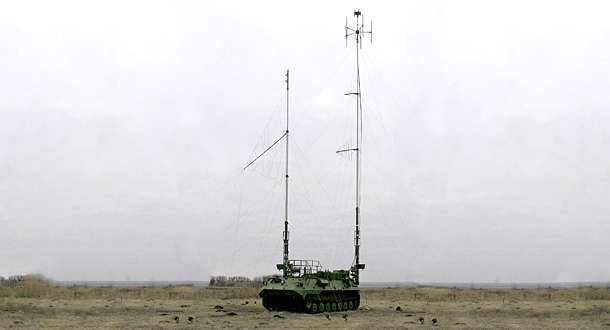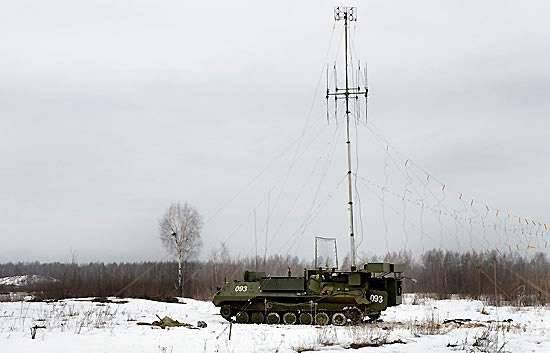The complex of electronic warfare RB-301B "Borisoglebsk-2"
History The newest electronic warfare system dates back to the late nineties and the beginning of the two thousandth. In 1999-2001, the Tambov Radio Engineering Research Institute (TNIIR) "Efir" was engaged in Borisoglebsk research and development work, the purpose of which was to upgrade the existing EW systems and the P-330B "Mandat" and P-378А jamming stations. Soon the institute received a task to modernize several other EW systems that were operated by the Russian armed forces. According to the results of the implementation of these design and development projects, the Efir received a new task to carry out a deep modernization of the existing technology, which in fact led to the appearance of completely new samples.
In 2004, a new project was launched, which received the symbol "Borisoglebsk-2". TNIIR “Efir” became the lead executor of these works, and the “Constellation” concern was to be responsible for the design, manufacture and supply of some radio-electronic systems. In 2009, the project team was changed. Due to the large experience in the development of electronic systems, including EW systems, the Sozvezdiya concern has become the main developer of the new project. This organization brought the project to the stage of mass production and is now responsible for the production of finished equipment.

It should be noted that the project “Borisoglebsk-2” achieved great success even before the change of the head developer. Already in 2009, the last stages of preliminary testing of the new complex were conducted. At the same time, active work was carried out on the conjugation of individual elements of the complex both with each other and with the control point. In 2010, state tests of the new complex were conducted, on the basis of which it was recommended for use.
Being a development of previous EW systems, the new Borisoglebsk-2 complex generally preserves their architecture. It includes the P-300KMV control point and individual machines with various radio-electronic equipment: P-378BMV, P-330BMB, P-934 BMW and P-325UMV. According to reports, the complete set of the complex includes nine different machines with a different set of equipment. All the facilities of the complex are placed on the MT-LBu self-propelled chassis, modified in connection with the installation of new special equipment. Such a chassis provides high mobility and throughput, allowing the Borisoglebsk-2 facilities to arrive in a timely manner in a given area and begin work there. In addition, there is a high degree of unification with other equipment of the armed forces. After arriving at the site of work, the complex requires about 15 minutes to deploy all the means and preparation for combat work.
All the facilities of the complex need adequate power supply, for which several diesel generators are included in the Borisoglebsk-2. In addition, it provides for the possibility of supplying power from an existing civil or industrial infrastructure. In this case, the machines of the complex can be connected to a network with a voltage of 220 V or 380 V and a frequency of 50 Hz. Regardless of the type of food complex is able to fully solve all the tasks.
The EBS complex Borisoglebsk-2 includes equipment of various types designed to solve a wide range of tasks. There are electronic reconnaissance assets designed to detect enemy radio signals and to provide data about them to other elements of the complex. Also provided are machines with equipment for direct jamming. All stages of combat work are carried out under the control and at the commands of the self-propelled control center, which processes the incoming data about the detected signals and gives instructions to the suppression systems.
According to available data, the overall coordination of the work of the complex involves the calculation of the P-300KMV control center, consisting of four people. Two of them have automated workstations to manage the work of all systems. One control station can control up to four pairs of jamming stations. In automatic mode, the solution provides up to 30 tasks.
Unfortunately, most of the information about the Borisoglebsk-2 complex is still a state secret, which is why, in particular, the main characteristics of the systems are not yet disclosed. Nevertheless, the main features of the complex and the range of tasks to be solved have already been announced. The main task of the complex is the detection and suppression of various communication channels and other systems using radio signals. First of all, these are communication systems and tactical control systems, including satellite ones. In addition, there is the possibility of suppression of radio navigation systems.
Similar possibilities existed among the previous EW systems of domestic production, however, in the new project Borisoglebsk-2, some innovations were applied, aimed at a significant increase in the characteristics of the equipment. Thus, one of the main ways to improve work efficiency has been the expansion of the frequency range in which the detection of enemy signals takes place. The frequency range of jamming stations was also expanded. This allows for more efficient detection and suppression of enemy radio channels.
Through the use of new equipment and related software, the scanning speed of the frequency range was increased when signals were detected at unknown frequencies. The response time was also reduced when the complex was operating at unknown frequencies. Measures have been taken to improve the accuracy of calculating the location of the radio source and to increase the bandwidth of the suppressor.
An important feature of the Borisoglebsk-2 complex is the enhancement of performance in the exploration and suppression of radio channels with a pseudo-random frequency tuning (PFC). According to reports, the new EW complex is able to find the VHF signal and suppress it at a frequency tuning rate of up to 300 jumps per second. Thus, it is provided an effective countermeasure to modern and advanced radio-electronic systems with the function of frequency hopping.
The control point and other means of the new electronic warfare complex are equipped with digital controls using the MAWS operating system. For greater convenience of the calculation, including in the case of a workplace change, the interfaces of all computer systems are made according to the same requirements, which allows the operator to use someone else's console without any particular difficulties. An interesting feature of the software of the complex, which has not yet become widely used in domestic systems, Borisoglebsk-2 has become the use of open architecture. As a basis for the operating system of the complex, an open core is used, to which the necessary modules are connected. This, in particular, simplifies and accelerates the development of updated software.
The complexity of modern electronic systems places high demands on the level of training of personnel. For the training of future operators of the Borisoglebsk-2 complex, a unified Magnesium simulator was developed, with the help of which it is proposed to carry out initial training of personnel.

The state tests of the radio-electronic warfare complex RB-301B “Borisoglebsk-2” were completed and successfully completed in 2010. Soon concern "Constellation" received an order for the deployment of mass production of such equipment with its subsequent delivery to the troops. It took some time for the production to be deployed, after which the first serial control stations and other machines of the advanced complex came off the conveyor. Later they were handed over to the armed forces.
In 2013, units of the Southern Military District received the first eight Borisoglebsk-2 complexes. The following year, several systems from this game were used during the competition of EW operators of the Southern Military District. More than 30 servicemen arrived at the Kalinovsky (Chechen Republic) training ground to participate in competitions, during which they demonstrated their skills in jamming and suppressing enemy radio channels.
In 2014, the new equipment received connections of the Eastern Military District. Already in September of the same year, the calculations of the Borisoglebsk-2 systems were brought to participate in tactical exercises with live firing. At these exercises, the task of the complexes was to counteract the conventional enemy who tried to use various radio-electronic means.
Production of serial EW complexes of the new type is still ongoing in the interests of various military units. So, last year, similar systems were supplied to the VBM motorized rifle formation deployed in Buryatia. It was reported that first, the specialists of the manufacturer sent a new technique, and then helped the military with its development. In addition, at the end of the training course, exercises were conducted in a field setting, the purpose of which was to test and consolidate the acquired skills.
Last year, the Sozvezdie concern and the state corporation Rostec, of which it is a part, reported successes in the production of new EW complexes. So, for 2014-15 years, the troops were supplied with 14 Borisoglebsk-2 complexes, which were mastered by the operators and put into full operation. Deliveries of new systems were carried out in subdivisions of all military districts: it was noted that the geography of deliveries is very wide - from Kaliningrad to Blagoveshchensk.
In December last year, the media got information about the planned continuation of production and supply of new complexes. So, for January 2016, the transfer of the Borisoglebsk-2 system and other modern EW complexes to the compounds of the Eastern Military District was planned. As of the end of December 2015, the facilities of the RB-301B complex were loaded onto railway platforms and were awaiting shipment to the duty station. It was reported that, in addition to the Borisoglebsk-2, the BBO troops should receive the Infauna complex, also designed to counter enemy’s electronic systems.
Through the use of existing experience and the latest developments of the Russian defense industry, it was possible to develop a new complex of electronic warfare for the ground forces, suitable for suppressing enemy communications, control, detection, etc. Several years ago, the Borisoglebsk-2 system went into series and is currently being delivered to army units. The account of the new complexes transferred to the customer has already gone to dozens. Thus, the assigned tasks are fully resolved and the new equipment already ensures the safety of the country, and thanks to the delivery of new machines, the potential of EW units is constantly growing.
On the materials of the sites:
http://tvzvezda.ru/
http://tass.ru/
http://nevskii-bastion.ru/
http://arms-expo.ru/
http://rosinform.ru/
http://sozvezdie.su/
Information